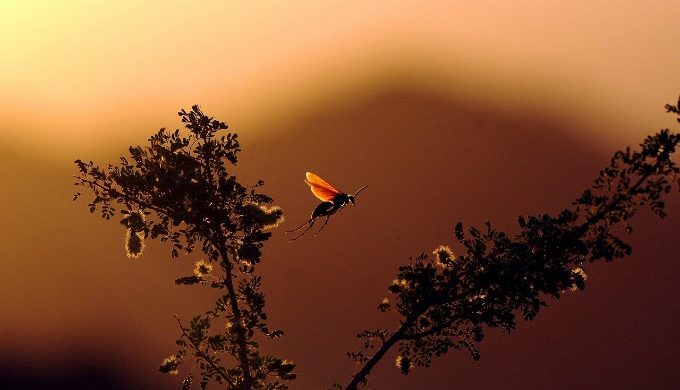Thanks to horror movies and spooky Halloween decor, giant spiders like tarantulas strike fear in the hearts of many. And, to be honest, when one lives in or visits the Texas Hill Country, it can be a bit unsettling when you see your first tarantula go scurrying across the road in front of you. Luckily, tarantulas (which are found all over Texas) are mostly harmless. They’re docile creatures that will only bite if provoked, and even then, their bite is only as severe as a bee sting. So, while tarantulas look intimidating but are harmless, there’s an insect that preys on tarantulas that is far more frightening.
Nature
What Could Be Scarier Than a Tarantula? A Tarantula Hawk!
The Tarantula Hawk

Photo: Flickr/Brian Van de Wetering
The tarantula hawk is an extra-large wasp (as large as two to three inches in length) whose larvae feed on tarantulas. Strikingly handsome with orange wings and blue-black bodies, tarantula hawks are ranked as having one of the most painful insect stings in the world. So, while they might look unassuming, they pack a punch.
According to Ben Hutchins of Texas Parks and Wildlife, “There are some vivid descriptions of people getting stung by these things, and their recommendation was to just lie down and start screaming, because few if any people could maintain verbal and physical coordination after getting stung by one of these things. You’re likely to just run off and hurt yourself. So just lie down and start yelling.”
Bad News For Tarantulas

Photo: Flickr/David Crummey
The good news is that tarantula hawks are not aggressive and don’t often sting humans, but they do sting tarantulas. The female tarantula hawk preys on tarantulas in order to feed her young. They will sting the spider, rendering it paralyzed and completely incapacitated, but still very much alive. Then she drags the tarantula, sometimes four times her size, into a burrow where she lays her eggs inside the abdomen of the spider. When the baby tarantula hawks hatch, they proceed to eat the flesh of the tarantula over the course of several weeks, avoiding its vital organs to prolong its life (and the young tarantula hawks’ food source).
Important Pollinators

Photo: Pixabay/Skeeze
Tarantula hawks sound like a menace, but the truth is that they’re fascinating parasites who are flourishing in Texas right now. Due to the severity of their sting, they don’t have any natural predators. And, although the tarantula hawk larvae feed on the flesh of tarantulas, adult tarantula hawks are exclusively nectar feeders. Here in Texas, they have an abundance of blooms to feed on and act as important pollinators in our ecosystem.
Hutchins adds, “Even though they do have a really painful sting, in my opinion they’re just a really cool component of our fauna,” says Hutchins. “People don’t really need to be afraid of them, and indeed I think they’re really cool to just sit and watch them in your yard.”



